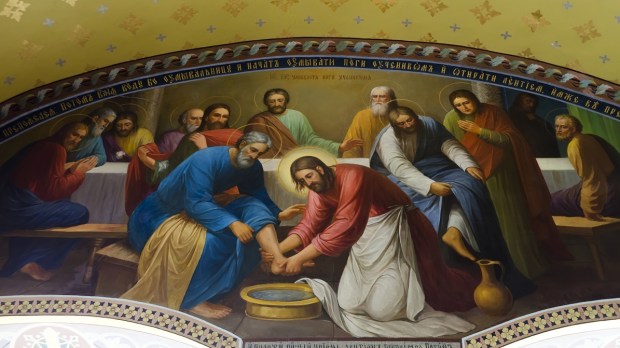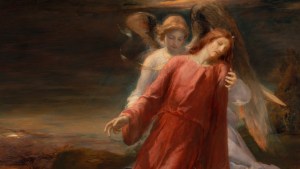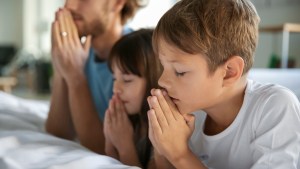Today, around the world, Christians begin observing the Sacred Triduum. Latin for “three days,” “Triduum” refers to three 24-hour cycles spanning four days — from the evening of Holy Thursday through the evening of Easter Sunday. It is the great commemoration of the Paschal Mystery: Christ’s Passion, Death, and Resurrection.
For those looking to supplement liturgical celebration with reading and reflection — or for those outside of the Church’s orbit entirely — I’d like to offer another “way in” to these sacred mysteries: the idea of the “both/and.”
I’ve written a book on the both/and, which is scheduled to release next year from Word on Fire. The heart of the argument is three closely related ideas: (1) our greatest dilemmas are those between “heaven” and “earth”; (2) our heaven-earth dilemmas are only resolved in Christ, the Way, who draws them into communion in himself; and (3) the fullness of the Way is in the Catholic Church, which is defined by the principle of “both/and” — tensions that honor both the contrast of heaven (which is distinct and primary) and its connection with earth (which remains good and beautiful).
But what are heaven and earth, exactly?
Under the guiding physical metaphor of the sky (the “heavens”) and the ground, the terms signify four metaphysical pairs: God and man, God’s place and man’s place (what most of us mean by “heaven and earth”), the spiritual and the physical (the two “sides” of the world), and spirit and flesh (the two “sides” of man). All of these meanings come together in the Bible, which is the very story of heaven and earth. The Bible reaches its culmination in Christ, who draws all these pairs together. In Christ, God gathers up and reconciles all heavenly and earthly reality (Eph 1:10; Col. 1:20).
Different events in Christ’s life highlight each pair, but we see all four stretch across the whole of his saving work; indeed, we can line up the four pairs to the four days spanning the Triduum.
We begin with Holy Thursday, where we see the primary principle of the both/and:the communion of God and man.
The foot-washing
We see it, in the first place, in Jesus’ washing of the feet of his disciples. John tells us that Jesus “got up from the table, took off his outer robe, and tied a towel around himself. Then he poured water into a basin and began to wash the disciples’ feet and to wipe them with the towel that was tied around him” (John 13:4–5). St. Peter vigorously protests — until the Lord tells him that he has to accept this act to have a share in Christ’s life.
Washing someone’s feet in the ancient world was considered a filthy, uncomfortable job reserved for slaves — which is why St. Peter saw it as beneath his Master’s dignity. Thus, the Church Fathers read this scene in light of the incarnational hymn in St. Paul’s Letter to the Philippians 2. “Christ Jesus,” Paul writes:
“though he was in the form of God,
did not regard equality with God
as something to be exploited,
but emptied himself,
taking the form of a slave,
being born in human likeness
And being found in human form,
he humbled himself … ” (Phil. 2:6–8)
Christ is divine but found in human form; he is both God and man and this is what the scene of the foot-washing so beautifully expresses. His removal of his outer garment signals his kenosis or self-emptying; his donning of a towel his “being born in human likeness”; and his descent to the feet of his disciples his great humility in drawing God down to serve man, so that man — represented here by Peter — might have a share with God.
The agony
We see the communion of God and man again in the agony in the garden, described in the three Synoptic Gospels. Matthew, Mark, and Luke speak of Jesus becoming distressed, agitated, and grieved, but there are two especially powerful verses that appear in Luke:
“Then an angel from heaven appeared to him and gave him strength. In his anguish he prayed more earnestly, and his sweat became like great drops of blood falling down on the ground” (Luke 22:43–44).
These two verses are often placed in double brackets, because while they do appear in ancient versions of Luke, they don’t appear in the earliest versions. Why were they so contested? One scholarly theory is that it was because these verses so vividly portray Christ’s humanity — his emotional and physical agonia (the only use of that term, translated as “anguish,” in the whole New Testament). Indeed, Irenaeus references Christ’s sweating of blood in his argument against the Docetists, who claimed that Christ was God, but only seemed to be human—and wasn’t really.
Today, we’re tempted to see Jesus as a purely human figure: a revolutionary, a guru, a spiritual teacher of timeless truths. The ancient world more often fell into the opposite temptation of seeing him as a purely divine figure: his human nature was really a cloak, a mirage, a ruse.
But Holy Thursday reminds us of the truth: Christ is both God and man.



